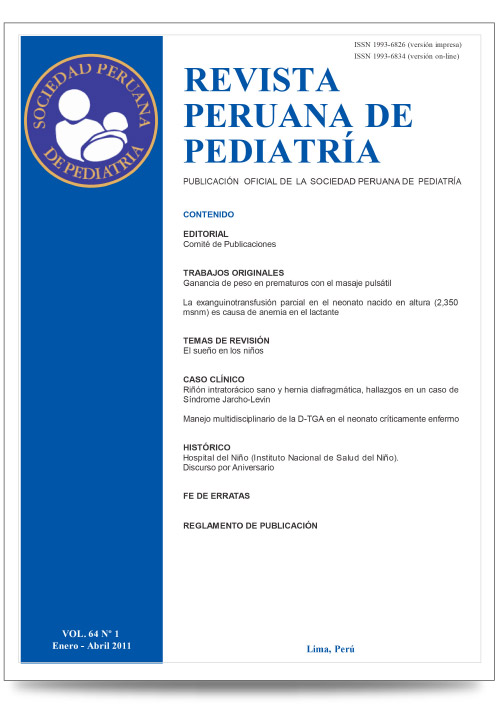Ganancy of weigh in premature babies with pulsated massage
DOI:
https://doi.org/10.61651/rped.2011v64n1p01-07Keywords:
Infant, Premature, Weight Gain, MassageAbstract
Introduction: There is evidence that premature babies who receive massages have a better evolution, in the psychomotor development and gain more weigh in comparison to a control group. The stress, pain and the lack of maternal contact in this phase of the life could be related to cognitive and behavior problems in the adolescence and adulthood. The massage decreases the stress and promotes the gain of weight in premature babies. Objective: To evaluate the effectiveness of the application of the pulsated massage – a tactile stimulation resembling to the intrauterine atmosphere-on the gain of weight in premature babies hospitalized in the UCIN of the Edgardo Rebagliati M. National Hospital.
Material and methods: Prospective study. The sample was constituted by 20 premature babies of 30-34 weeks of EG. In 10 of them the stimuli was applied through the pulsating stimulator (Invention: Prize Gold medal Geneva-Switzerland 2000) and the other 10 constituted the control group. The stimulus was administered during 7 days in the Unit of Intermediate Cares. The weight of entrance, the daily weight and the final weight were controlled.
Results: Average of 33 g./day was observed as a gain of weight in the stimulated group and 26 g./day in the control group during the 7 days of the study. The experimental group gained 28.4% more weight than the control group. The analysis with statistical package SPSS 12.0 and t test showed this was a significant difference (p<0.05).
Conclusions and recommendations: There is a benefit in the weight of the premature ones put under pulsating stimulation, resembling the intrauterine environment. Its use would be recommendable in premature and newborn of high risk, when there is not possible to apply to kangaroo mother method and in those who suffer the lack of maternal contact, stress and pain frequently.
Downloads
Downloads
Published
How to Cite
License

This work is licensed under a Creative Commons Attribution 4.0 International License.
Authors will retain the copyright and grant the right to publish their work in the journal while allowing third parties to share it under the Creative Commons Attribution license.
Articles are published under a Creative Commons license that allows sharing and adaptation with appropriate credit. CC BY 4.0 license. Available in English at https://creativecommons.org/licenses/by/4.0/
Authors may use other information disclosure formats as long as the initial publication in the journal is cited. The dissemination of the work through the Internet is recommended to increase citations and promote academic exchanges.
The published content does not necessarily reflect the specific point of view of the journal, and the authors assume full responsibility for the content of their article.




